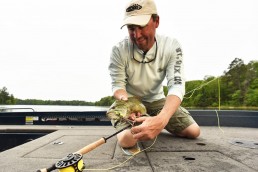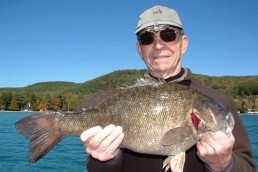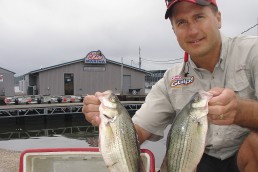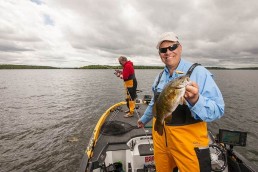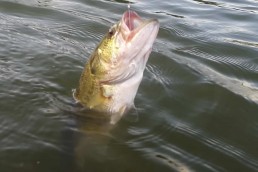SHARE THIS POST
Statistics show bass are the most sought-after gamefish in the country. This means there are not many offerings a largemouth, smallmouth or spotted bass haven’t seen. Anglers have steadily reeled, dragged and juddered about every lure conceivable past their lateral lines.
Ichthyologists have verified some fish species are capable of short-term memory—bass are one. Even though there’s no calculus or geometry processing throughout their pea-sized brains, bass are smart. When one gets stressed out too many times from getting sore-lipped from, say, a white spinnerbait, chances are that the fish will turn tail next time one goes ripping by them.
So what are anglers to do when the catching gets tough, especially in waterways with heavy fishing pressure?
Give them something they don’t often see, but that doesn’t always mean rooting around the bottom of the tackle box for a rusty, undependable lure. Backsliding in time to one of the oldest techniques known for fooling fish may just be the ticket—I’m talking about fly fishing.
Modern fly-tying materials allow the gurus of this community to create realistic minnow, crustacean and aquatic insect replications never seen before. And some of the biggest flies can be fished aggressively when it’s called for. There are times fly fishing lets you present an offering in ways standard spinning and casting gear can’t. And, frequently, the practice will outperform standard techniques.
Crossing the line
I first met Russ Maddin on the banks of a river near my hometown of Traverse City, Mich., 25 years ago. The fly angler extraordinaire was casting and testing out huge streamers newly designed and tied—little did I realize I was observing the beginning of the big streamer revolution for behemoth trout. I also didn’t envision these big streamers would someday be crossing the line, becoming a staple for catching big bass.
“A bunch of the streamers we have concocted for big browns over the years are indispensable for bass, too,” Maddin said. “We really whack them on ‘em because of how they dart, and the flash of the material reflects a lot of light.”
While the tried-and-true streamers like 3- and 4-inch Clouser Deep Minnows still fool bass, many of today’s articulated flies—the Circus Peanut, Flash Monkey and Murdich Minnow—measure out to 5 to 6 inches or more. And, they have a swimming action that rivals the top jointed body baits and jerkbaits. To boot, unlike plastic or balsa baits, the soft synthetic and feathery materials never quit moving, even pulsating if the fly’s sitting stationary. Streamers rule when fished at high- speed, with the hustle generating the strikes.
Ploopin’ and ploppin’
Do you love catching bass on a topwater lure? Who doesn’t?
The attack from a bass as it throttles a big topwater bug is exhilarating. Big poppers are a standard, and they can often be fished in areas most lures can’t. Most bass flies are tied on big, single hooks. Add a strand of heavy monofilament over that to surround the point and you’ve got one heck of a snag-proof presentation even the thickest lily pad or milfoil bed can’t grab.
Then there are the subsurface flies, which dive mere inches under the surface such as the Dahlberg Diver and Umpqua Swimming Baitfish. These patterns work wonders when young-of-the-year fishes are eating emerging bugs and the bass are targeting the fish rather than the insects. One retrieve is to recover line so the diving fly dips under the surface for a few feet. Then, you give it a pause. This imitates a small fish swimming about, stopping to eat bugs. But don’t let this be your only technique; steady retrieves are always worth a try.
Are you enjoying this post?
You can be among the first to get the latest info on where to go, what to use and how to use it!
Falling slowly
Fly fishing is severely overlooked by lake-bound bass anglers. Consider that period in summer when your sonar absolutely clogs with clutter. Those zillions of tiny specks on the screen signify mayfly nymphs wiggling their way up from the bottom. This is where smaller “jigging” flies come into play. These are tied with heaps of marabou-like feathers, which undulate non-stop like a nymph’s gills, and are also tied with weighted eyes so they waft ever so slowly down through the water column. Work them slowly on or near the bottom with a stop and go, and hang on.
Out of the box
Can soft plastics be rigged onto fly tippets and allowed to sink at a snail’s pace? You bet.
Back in the day, my father would hook a nightcrawler mid-point—known today as wacky rigging—lob it out into the drink and let it fall like a feather. Needless to say, he outfished everyone. Wacky-rig a do-nothing-type worm and you’ll see results.
I tried something similar last year—nose-nipping a Custom Jigs & Spins’ Pulse-R Paddle Tail with a size 6 octopus-style hook with no additional weight. The ultra-slow fall was too tantalizing for smallmouths to pass up. Cast the same rig on conventional gear and the bait wouldn’t make it 3 feet past the tip. But with the right fly rod, the offering can be cast 100 feet or more; the clearer the water, the farther your cast needs to be.
Gear head
Today’s fly rods are becoming as technique-specific as standard spinning gear.
Maddin has been into casting shorter sticks lately, with lengths under 8 feet slowly taking over his arsenal. Because of his fixation with the short rod, I opted to try out St. Croix’s new 7-foot 11-inch Mojo Bass Fly, which is within bass tournament regulations at less than 8 feet.
“You can make a more accurate cast with a short rod, which is imperative for catching all species of fish,” Maddin says. “Bass during a cold front, for example, won’t move a mere inch off structure to eat. Your fly needs to be spot-on each and every cast.”
If you’re not sold on short rods yet, St. Croix’s 9-foot Bank Robber series—which was designed for casting big streamers by fly guru Kelly Galloup—also works wonders for topwater and slow-falling flies. The most versatile fly rod for catching bass is a 7 or 8 weight. As for lines, it’s best to have three reels or a couple extra spools filled with different types. A weight-forward floating line is needed for topwater, an intermediate sinking line for slow-falling flies and a sinking line for streamers and the like.
Whip it out
Fly fishing for bass is not the dainty dabbling of tiny flies many think it is. Big streamers fished aggressively will rock a bass angler’s world. Topwater is still exhilarating, and the slow fall will catch fish during the most difficult conditions. MWO
MWO
SHARE THIS POST
Did you enjoy this post?
You can be among the first to get the latest info on where to go, what to use and how to use it!
MWO
We believe being outdoors is good. With more than 1,000 articles each year, MidWest Outdoors magazine is all about sharing outdoor experiences with you—where to go, what to use and how to use it… whether you’re close to home or on that trip of a lifetime.
